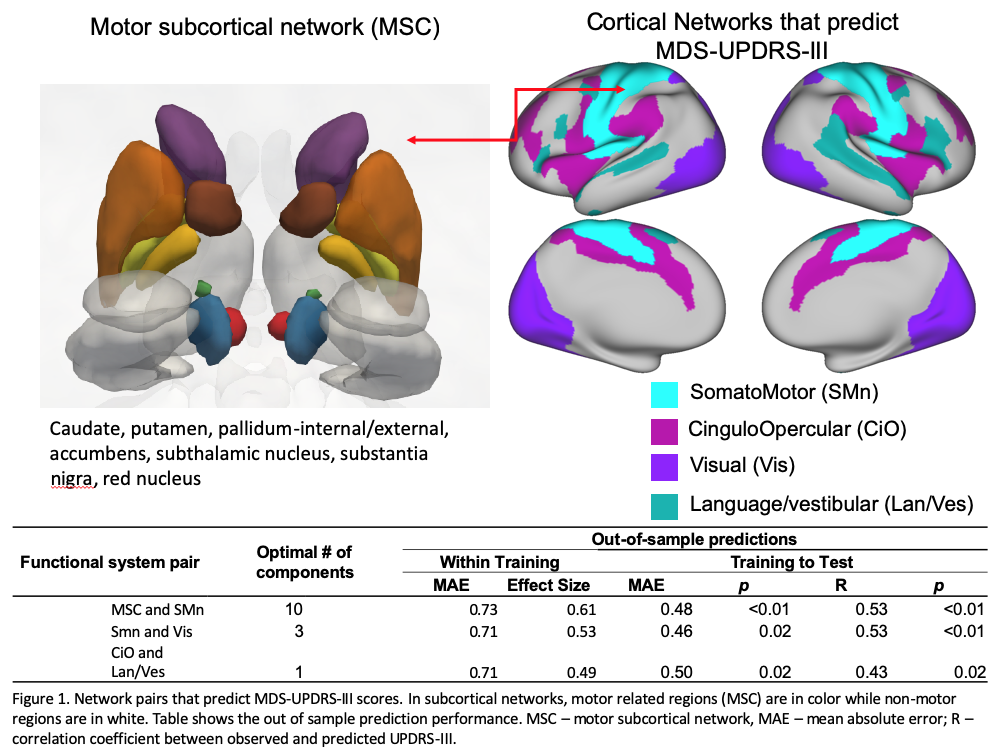Category: Parkinson's Disease: Neuroimaging
Objective: Investigate the functional connectivity network pairs associated with the motor symptoms in people with Parkinson’s disease (pwPD).
Background: PD is a neurodegenerative disorder primarily diagnosed and characterized by motor dysfunction. Functional MRI offers a unique opportunity to non-invasively characterize brain function. In this study, we hypothesized that the motor functions observed in PD may involve connectivity in higher-level attention networks. Understanding the resting state functional networks that correlate with the severity of the motor symptoms would be valuable to understand the disease physiology.
Method: Our sample consisted of 88 subjects (mean age: 68.2(SD:10), 55M/33F). Motor severity of pwPD was assessed in practical OFF medication state, using MDS‐UPDRS Part‐III scores (mean: 49 (SD:10)). MRI data was processed using an adapted version of human connectome project pipeline [1]. HCP Cole Anticevic atlas was used for creating cortical functional connectivity networks [3]. For subcortical network, we included the regions that are likely involved in motor symptoms in PD as motor subcortical network (MSC, figure 1). We used training (N=64) and test (N=24) data for predictive modelling. PLSR models were used to predict MDS-UPDRS-III scores based on functional connectivity using the training dataset and optimized by leave-3-out cross validation [4,5]. The most predictive modes were then used to predict MDS-UPDRS-III in the test dataset.
Results: The top 5% PLSR models that predicted the MDS-UPDRS-III scores with effect size > 0.5 were the somatomotor (SMN) and MSC (d=0.6, components=10), SMN and Visual (d=0.5, components=3) and Cinguloopercular and language/vestibular (d=0.5, components=1) networks (figure 1).
Conclusion: Our finding suggests that along with motor networks, visual- and attention-related cortical networks are also impacted in the motor symptoms of PD. SMN has been consistently observed in the PD literature [6,7]. Cingulo-opercular network is known to be involved in tasks that require tonic alertness [8]. When pwPD have deficits in motor networks, probably more attention is required to carry out motor functions. Characterization of functional network during evolution of motor symptoms could be helpful in understanding the contribution of non-motor cortical regions in parkinsonian movement disorders and/or compensatory mechanisms.
References: [1] dsturge, Earl E, kathy-snider (2019) DCAN-Labs/abcd-hcp-pipeline: v0.0.1: Singularity hotfix. [2] Glasser MF, Sotiropoulos SN, Wilson JA, Coalson TS, Fischl B, Andersson JL, Xu J, Jbabdi S, Webster M, Polimeni JR, Van Essen DC, Jenkinson M (2013) The minimal preprocessing pipelines for the Human Connectome Project. Neuroimage 80, 105–124. [3] Ji JL, Spronk M, Kulkarni K, Repovš G, Anticevic A, Cole MW (2019) Mapping the human brain’s cortical-subcortical functional network organization. Neuroimage 185, 35–57. [4] Silva‐Batista C, Ragothaman A, Mancini M, Carlson‐Kuhta P, Harker G, Jung SH, Nutt JG, Fair DA, Horak FB, Miranda‐Domínguez O (2021) Cortical thickness as predictor of response to exercise in people with Parkinson’s disease. Hum Brain Mapp 42, 139–153. [5] Miranda-Domínguez Ó, Ragothaman A, Hermosillo R, Feczko E, Morris R, Carlson-Kuhta P, Nutt JG, Mancini M, Fair D, Horak FB (2020) Lateralized Connectivity between Globus Pallidus and Motor Cortex is Associated with Freezing of Gait in Parkinson’s Disease. Neuroscience 443, 44–58. [6] Strafella AP, Bohnen NI, Pavese N, Vaillancourt DE, Eimeren T, Politis M, Tessitore A, Ghadery C, Lewis S (2018) Imaging Markers of Progression in Parkinson’s Disease. Mov Disord Clin Pract 5, 586–596. [7] Tessitore A, Giordano A, De Micco R, Russo A, Tedeschi G (2014) Sensorimotor Connectivity in Parkinson’s Disease: The Role of Functional Neuroimaging. Front Neurol 5, 180. [8] Sadaghiani S, D’Esposito M (2015) Functional Characterization of the Cingulo-Opercular Network in the Maintenance of Tonic Alertness. Cereb Cortex 25, 2763–2773.
To cite this abstract in AMA style:
A. Ragothaman, M. Mancini, J. Nutt, D. Fair, O. Miranda-Dominguez, F. Horak. Resting state functional connectivity networks related to MDS-UPDRS motor outcomes in Parkinson’s Disease [abstract]. Mov Disord. 2021; 36 (suppl 1). https://www.mdsabstracts.org/abstract/resting-state-functional-connectivity-networks-related-to-mds-updrs-motor-outcomes-in-parkinsons-disease/. Accessed April 20, 2025.« Back to MDS Virtual Congress 2021
MDS Abstracts - https://www.mdsabstracts.org/abstract/resting-state-functional-connectivity-networks-related-to-mds-updrs-motor-outcomes-in-parkinsons-disease/

